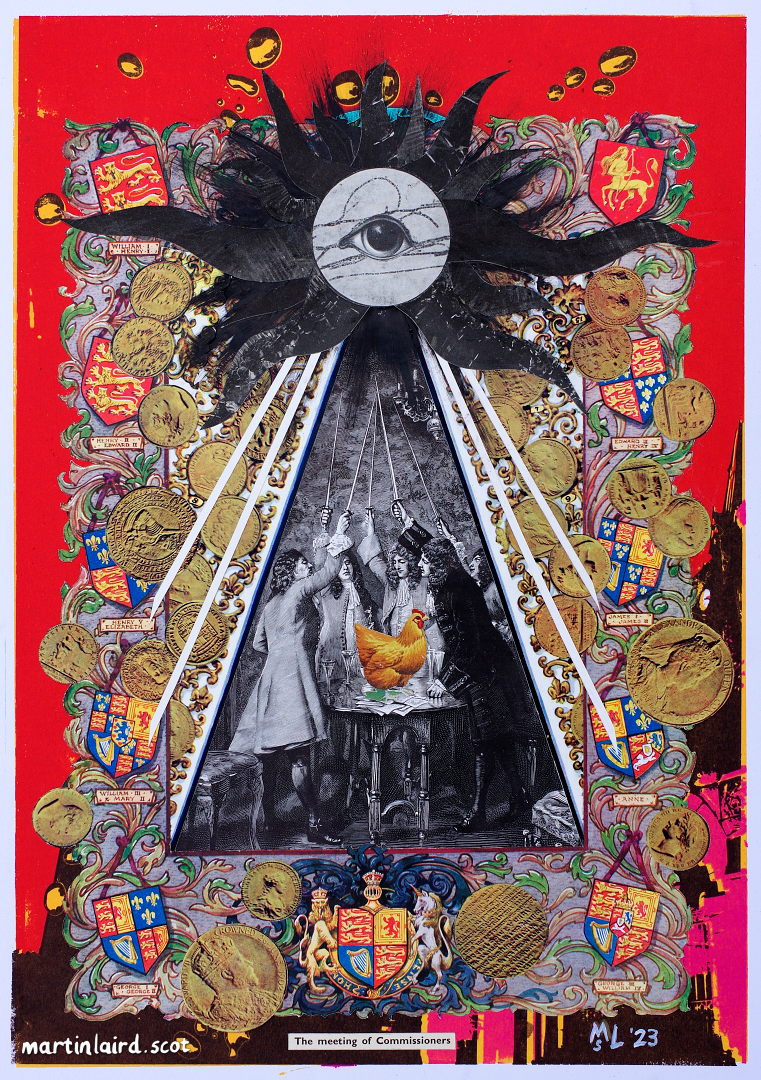Your basket is currently empty!
The Meeting of Commissioners

The Meeting of Commissioners – a collage
The Meeting of Commissioners is a collage inspired by the incendiary memoirs of George Lockhart of Carnwath, which are a fascinating insight into the nefarious ways the Union between Scotland and England was brought about in the early 18th Century. They completely demolish the lie that the Scotland entered the Union voluntarily. Lockhart names and shames all the self-serving individuals responsible for selling out the sovereignty of the people of Scotland, detailing their individual motivations (and their price). These men (along with some Parliamentarians) are the infamous ‘Parcel of Rogues’ of Robert Burns‘ poem. Lockhart’s memoirs are a primary source from the period also studied by Walter Scott for his writing.
“(an act) was framed and passed in Parliament, but withal so imperious and haughty that the like treatment was never given by one nation to another. For in the very act itself they direct the Scots Parliament after what manner the Scots commissioners were to be chosen, expressly prohibiting their own commissioners (whom they allowed the queen to name) to meet and treat with those of Scotland unless the Parliament of Scotland did allow the queen the naming and appointing of them.
And further to frighten the Scots into a compliance, they declare all Scotsmen to be aliens and incapable to enjoy the liberties and privileges of Englishmen, prohibit the importation of Scots cattle and linen cloth into England and exportation of horses and arms into Scotland, and ordain that ships should be appointed to disturb and molest the Scots trade; with several other prohibiting clauses, all of which were to take place about eight months thereafter, viz. Christmas 1705.
Then they addressed the queen that she would grant the royal assent to the abovementioned act and give orders to send down troops to the borders and put the towns of Newcastle, Tinmouth, Berwick, Carlisle and Hull in a posture of defence.”
‘Scotland’s Ruine’ Lockhart of Carnwath’s Memoirs of the Union, edited by Daniel Szechi, The Association for Scottish Literary Studies, 1995.
Much to his surprise, Lockhart himself was appointed one of the commissioners. He was a known Jacobite and the only one of the commissioners from Scotland actually opposed to the Union with England. He was reluctant to take part, knowing that he would have no influence, but his friends advised him to attend the negotiations, say nothing, and record everything that happened. This he did, and he paints a vivid picture of capitulation, plotting, intimidation, bribery, and betrayal.
Once the commissioners had agreed the Acts of Union, they were then rushed through the Scottish Parliament. The members knew that the people were greatly opposed and they did not have a mandate, but that once the deed was done it would be impossible to undo. The Union passed thanks to the actions of two-faced individuals such as James, 4th Duke of Hamilton. Hamilton was thought a hero by the Scottish people, who saw him as one of the champions who would prevent Union with England. While they rioted and tried to burn down the houses of those they knew were betraying them, they huzzah’d the Duke of Hamilton. However he betrayed them too, and his own friends and allies – many times over in the years to come. Lockhart doesn’t seem to have ever been able to reconcile the depths of this betrayal by a man he clearly admired.
“As always, it is a clever woman who can best understand a complicated man; and the Countess’ (of Errol) final comment summed him up. The Duke, she said, ‘was ensnaired in the Union by the bait of a double interest’. It was his Duchess’ Lancashire inheritance that had done it.”
Playing the Scottish Card – The Franco-Jacobite Invasion of 1708. John S Gibson, Edinburgh University Press, 1988.
by